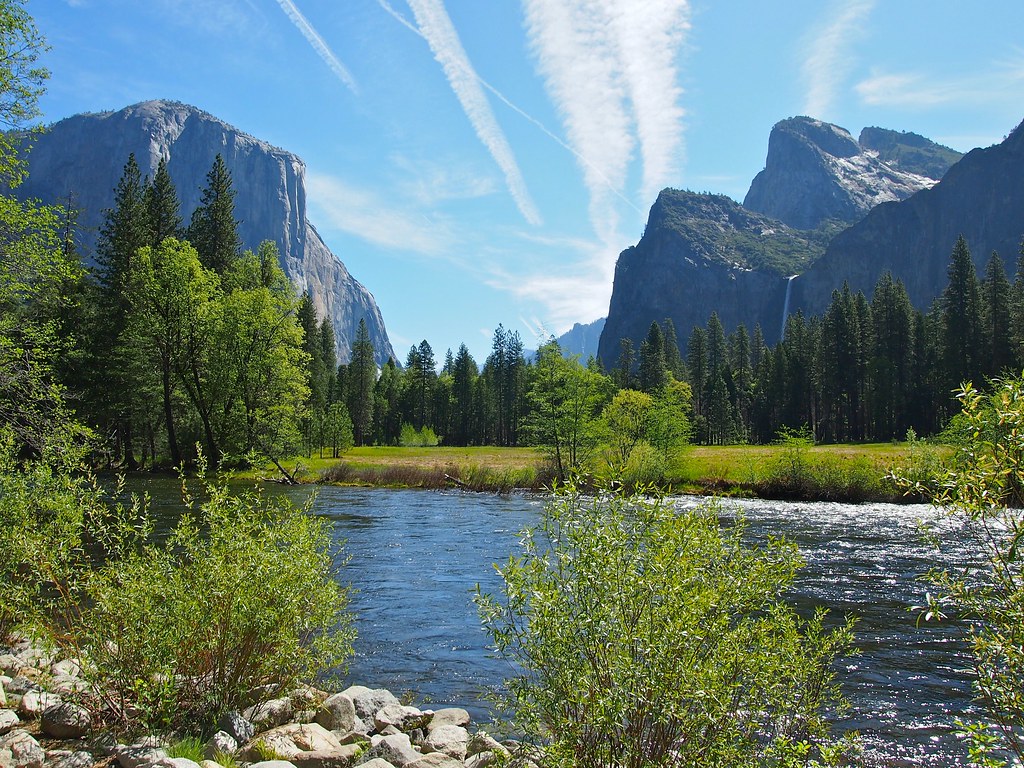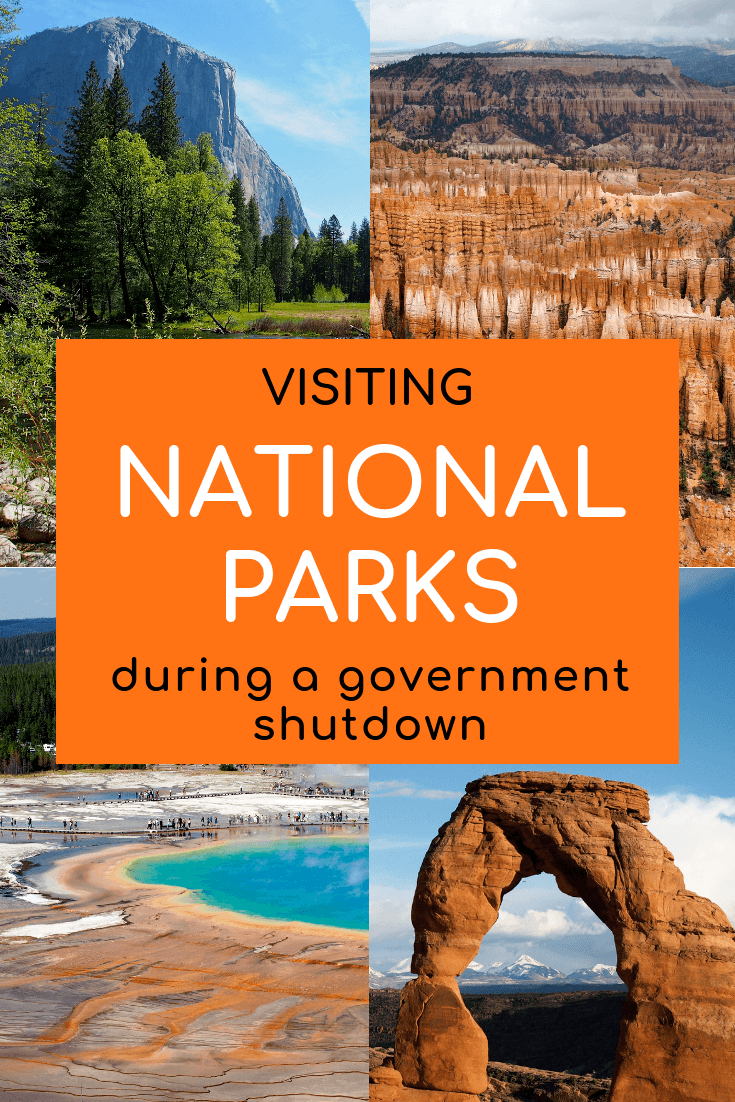

As I slowly navigated the icy road leading into Grand Canyon National Park, I found myself feeling uneasy; and it wasn’t just because of the slippery road.
I was visiting the Grand Canyon in the first couple of days of 2019. It was supposed to be a fun holiday break trip with a friend who’s always dreamed of visiting the Grand Canyon. But our visit unfortunately coincided with a partial government shutdown that was, at that point, going into its second week.
The National Park Service is a federal agency, and is one that is almost always affected when the US government shuts down over budgetary issues.
I knew we could still visit the Grand Canyon during the 2019 shutdown; after backlash over national parks and lands completely closing during a shutdown in October 2013, changes were made to how the National Park Service dealt with shutdowns. Most NPS lands remained technically open to visitors.
But just because you can visit a national park during a shutdown doesn’t necessarily mean you should.
After the 2018-19 shutdown when ignorant visitors trashed restrooms and destroyed natural resources at some parks, the question has once again been raised about whether parks should remain open during full government shutdowns.
And as we enter into another government shutdown in October 2025, we need to talk about it again!
How a government shutdown can affect your travel plans

My trip to the Southwest and the Grand Canyon was planned before the government shutdown went into effect, and canceling it wasn’t really an option.
This is true for most people with trips planned during a shutdown. In many cases, you’ve already made plans and paid for things — and most travel insurance policies don’t recognize a government shutdown as a refundable reason for trip cancelation.
The good news is that most essential travel services are still available during a partial or full shutdown. A number of air traffic controllers, air marshals, and Transportation Security Administration (TSA) officers are deemed essential and are still expected to report to work — though remember that they aren’t being paid to be at work, so make sure you allow yourself extra travel time and extend a little extra kindness to any federal employees you meet.
If you’re traveling from abroad, the US still keeps its embassies and consulates open during shutdowns, and travelers can still apply for and receive entry visas.
The actual act of traveling in the United States during a government shutdown isn’t severely impacted. But the places you can visit very often are.

What’s open and what’s closed in a government shutdown
From a tourist perspective, you’re probably most concerned with what’s open and what’s not during the shutdown.
During the 2019 shutdown (and likely any others that might happen in the future), federal buildings and monuments that could be locked up were closed entirely. This included places like the Smithsonian museums, the National Zoo, and some federal monuments.
Basically, if it’s an attraction run by the federal government, chances are it’ll be closed during a shutdown.*
*Note: In the 2025 shutdown, so far the Smithsonian Museums and Zoo in Washington DC remain open, and plan to be open at least through October 6. I’ll update this with any new info!
The exception here was national parks.
After backlash over parks being fully closed during a shutdown in 2013, the federal government kept them open(ish) during the 2018-19 shutdown by using entry fees to keep things running. Unfortunately, this decision was later found to be illegal after an investigation by the Government Accountability Office, leading most people to believe that national parks would close their gates during any future shutdowns.
At the start of the 2025 shutdown, however, the National Park Service said it planned to keep parks “as accessible as possible” during the shutdown. But that doesn’t necessarily mean they will be or stay fully “open.”
Can you visit national parks during a government shutdown?
The short answer is: yes, sort of, for a while at least.
In the 2018-19 shutdown, roads, lookouts, trails, and open-air memorials inside most of the United States’ national parks were still accessible during the government shutdown.
BUT the longer answer is that, while parks were still accessible during the last shutdown, they weren’t necessarily “open.”
During the last shutdown at national parks, most national park rangers and employees were furloughed. Visitor centers were closed, entrance fees weren’t collected, educational programs were all canceled, and campsites were not staffed. In some cases, restrooms were closed and services like trash collection and road maintenance were suspended (this included snow removal; Arches National Park in Utah was completely closed due to snow in January 2019, for example).
There were also fewer emergency/rescue services available, and the NPS didn’t update its website with information for any of its parks.
So, in short, the parks were “open” in the sense that you could still access them, but all services within them were closed, and in many cases you were visiting at your own risk.

2025 shutdown at national parks
In September 2025, the Department of the Interior released a “Contingency Plan for a Potential Lapse in Appropriations” for the National Park Service that details how the agency will handle a potential shutdown. (And yes, I read this entire document so you don’t have to!)
In short, the 2025 shutdown sounds like it will look at lot like it did in 2018-19.
A handful of NPS employees deemed essential, or who carry out duties related to safety are “exempted” from any shutdown furloughs. This includes basically a skeleton staff at NPS Headquarters and regional offices, and however many employees it takes at each park to ensure “the protection of life, property, and public health and safety.”
But otherwise, “the NPS is conducting no park operations and providing no visitor services” at individual parks.

What to expect in 2025, according to the DOI:
- Park roads, trails, lookouts, and open-air memorials will “generally remain accessible to visitors.”
- Buildings and parking lots that normally are locked overnight will be locked/inaccessible during the shutdown – this includes visitor centers.
- Parks will provide basic services to maintain restrooms, trash collection, road maintenance, campground operations, law enforcement and emergency operations, and entrance gate staffing to provide safety information. (Though this seems to only apply to parks that have extra available FLREA recreation fees; for parks that don’t, some of these services may not be available.)
- Emergency operations in some parks may be limited.
- Park websites and social media will not be updated, except for necessary emergency communications.
- Parks will not provide road or trail condition updates. (And this matters in some parks where October often brings the first snowfall of the year.)
- At parks without “accessible areas,” no visitor services will be provided at all (no permits, no educational programs, no restroom access or trash collection, no road maintenance, etc.).
And the document also states that parks may close any areas considered to be sensitive (from a natural, cultural, or historic perspective) if there are fears of destruction/damage, or if the safety of the public or wildlife is at risk. Basically meaning that if visitors trash a park during a shutdown, it might close entirely (because yes, this happened during the last shutdown).

Third party help
If national parks were to completely close during a shutdown (as they did for the first half of the 2013 shutdown), the National Park Foundation estimated that 715,000 travelers’ plans would be affected each day. That’s a lot of unhappy travelers.
So, to help combat this, many state governments and third parties have stepped up to fund services at some of the more popular national parks and monuments during past shutdowns. This is allowed, according to the 2025 contingency plan; individual parks can work with state, local, or tribal governments and/or third parties to fund operations.

Places where third parties funded services during the 2019 shutdown included:
- Grand Canyon National Park – The state of Arizona funded custodial services to keep restrooms open, continue trash collection, and perform snow removal on trails and sidewalks.
- Zion and Bryce Canyon national parks – The state of Utah funded custodial services and even staffed visitor centers for as long as it could.
- Yellowstone National Park – Yellowstone isn’t super accessible during the winter anyway, but private companies paid to keep trails and roads groomed, and to clean park restrooms.
- National Mall – In Washington, DC, private concessions provided restrooms at several spots along the National Mall, and trash collection still happened thanks to volunteers and non-government organizations.
- Statue of Liberty – New York state paid to keep the Statue of Liberty and Ellis Island open.
When I visited the Grand Canyon on January 1 and 2 in 2019, there was definite evidence of the shutdown. No entrance fees were being collected at the gates, and the visitor center was locked.
But most other services were running smoothly. Restrooms were being kept clean, snow removal was happening in the parking lots (I visited right after a snowstorm blew through northern Arizona), park shuttles were running, and all the lodges and restaurants in Grand Canyon Village were open.

This is because Arizona was paying for some services to continue, and others (like the running of lodges and restaurants) are taken care of by private concessions that don’t rely on NPS staff/resources and therefore aren’t affected by federal shutdowns.
However, as any shutdown drags on, the money provided by state governments, non-profits, and other entities can only go so far.
(We also have no clue which state governments and third parties might step in to help keep national parks running during the 2025 shutdown.)
How national parks are hurt by a shutdown
As I alluded to at the beginning of this post, I went through a bit of inner turmoil about visiting a national park during the government shutdown.
Sure, it turned out that the Grand Canyon was being taken care of. But the same isn’t always true at many other parks.

Most notably, Joshua Tree National Park closed its gates and campgrounds in 2019 because of sanitation issues at the campgrounds and safety issues (both for visitors and the natural environment) in the park — people were cutting down Joshua Trees (!!!!).
At other parks, there were reports of overflowing trash cans, human feces in places human feces isn’t supposed to be, and a general disregard of the rules that usually keeps our national parks pristine.
Some national parks had to dip into entrance fee funds to try to clean things up — funds that they usually rely on for other things throughout the year.
One of the big things I fretted over as I visited Grand Canyon National Park was not paying my entrance fee. As car after car rolled through the open gates, I couldn’t help thinking about how much money the parks were losing during the shutdown.
And, indeed, the National Parks Conservation Association estimates that the NPS lost $400,000 per day from entrance fee revenue during the last shutdown. PER DAY, people. That’s not an insignificant amount of money.

(If you want to ensure the NPS can benefit from your entrance fee, consider purchasing an annual pass to all US national parks during a time when a shutdown isn’t happening. These passes cost $80 and are good at any National Park Service-managed site for one year.)
Should you visit a national park during a shutdown?
People tend to take advantage of free entry to many national parks during government shutdowns, and many others (understandably) don’t alter their travel plans to avoid visiting them.
But should you be visiting national parks during a shutdown?
There’s no clear answer. Some people say no, simply because many visitors don’t respect national parks and monuments when there are no park rangers around to encourage good behavior and enforce rules.
I personally would say that *if* they keep the gates open, then it’s okay to visit most national parks during a shutdown — as long as you’re committed to visiting responsibly. (If they close the gates, though, then no, you definitely should not break in to visit.)

How to visit a park responsibly during a government shutdown
If you don’t want to cancel your trip to the Grand Canyon or Yosemite or Zion during a government shutdown AND those parks remain open, here are some tips for how to visit national parks responsibly:
- Carry out any and all trash. Even if there are trash receptacles available, consider carrying out anything you bring in anyway. It’s not that difficult to stuff an extra reusable bag into your day pack so you can carry out everything you bring in. (And please note that this includes food waste like orange and banana peels, too — those don’t belong in the woods and don’t break down as quickly as you probably think.)
- If you planned to camp, consider alternative lodging options if possible. If not, please, please, please clean up after yourself (and pack your own toilet paper), and only camp in designated areas that remain open/accessible.
- Respect signs and stay on the trail. Just because there aren’t park rangers around doesn’t give you free reign to go wherever you please. Many national parks and monuments exist to protect fragile ecosystems and natural wonders that cannot be replaced. If you see a sign asking you to stay on designated trails, please respect them — and this goes for keeping dogs on leashes, too!
- Follow Leave No Trace principles. Which are basically: be prepared, clean up after yourself, and don’t be an asshole.
- Consider donating to the parks. Since the National Park Service doesn’t collect park fees during a shutdown, consider making a donation on your own to the National Park Foundation, especially if you visit a national park that would normally charge a fee.
- Consider alternatives to national parks. Lastly, if you have some flexibility in your plans, consider visiting state parks that are close to national parks instead. They’re often just as beautiful, but won’t be suffering from the government shutdown.
And, for goodness’ sake, if a park or monument is closed during a shutdown, DON’T break in. It is not your right to visit a place that is closed or off-limits.

National park alternatives
There are hundreds of national parks and monuments all across the United States — but there are hundreds MORE state parks.
Many state parks are located adjacent or very close to national parks, meaning you can still contribute to the local economy while avoiding adding to the strain most national parks face during a shutdown. (Because no, you visiting a national park during a shutdown when the NPS is actively losing money is not “helping” in any way.)
Some state parks you can visit near popular national parks include:
- Snow Canyon State Park instead of Zion National Park in Utah
- Goblin Valley State Park instead of Bryce Canyon National Park in Utah
- Dead Horse Point State Park instead of Canyonlands National Park in Utah
- Monument Valley Navajo Tribal Park instead of Arches National Park in Utah
- Mount Mitchell State Park instead of Great Smoky Mountain National Park in North Carolina
- Lamoine State Park instead of Acadia National Park in Maine
- Bogachiel State Park instead of Olympic National Park in Washington
- Calaveras Big Trees State Park (for sequoias) instead of Yosemite National Park in California
- Anza-Borrego Desert State Park instead of Joshua Tree National Park in California
- Valley of Fire State Park in Nevada instead of Death Valley National Park in California
- Golden Gate Canyon State Park instead of Rocky Mountain National Park in Colorado
- Big Bend Ranch State Park instead of Big Bend National Park in Texas
- Custer State Park instead of Badlands National Park in South Dakota
- Fakahatchee Strand State Preserve instead of Everglades National Park in Florida
And instead of the Grand Canyon, you could visit Valley of Fire State Park in Nevada, or Red Rock State Park in Arizona, both of which are only a couple hours away.

So, to sum up everything in this post: National parks may still technically be open during a government shutdown, but many services won’t be available, and you’ll be taking your safety into your own hands if you choose to visit.
You may still be able to visit national parks during a shutdown, but I recommend visiting carefully (and responsibly!), or, better yet, visiting state parks instead if you can.
Want to read more about national parks?
Here are some posts on some of my favorite national parks and monuments for further reading:
Have you visited a national park during the government shutdown? Do you have any other questions about visiting?
Pin it for later:


Amanda Williams is the award-winning blogger behind A Dangerous Business Travel Blog. She has traveled to more than 60 countries on 6 continents from her home base in Ohio, specializing in experiential and thoughtful travel through the US, Europe, and rest of the world. Amanda only shares tips based on her personal experiences and places she’s actually traveled!